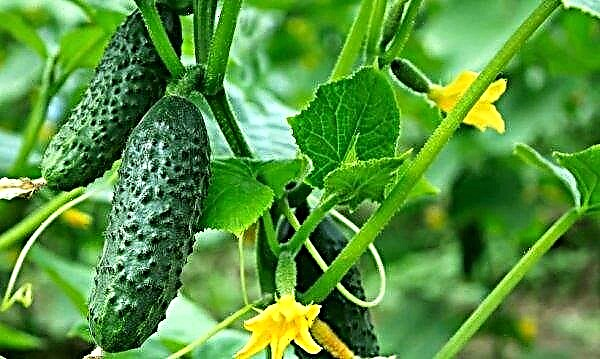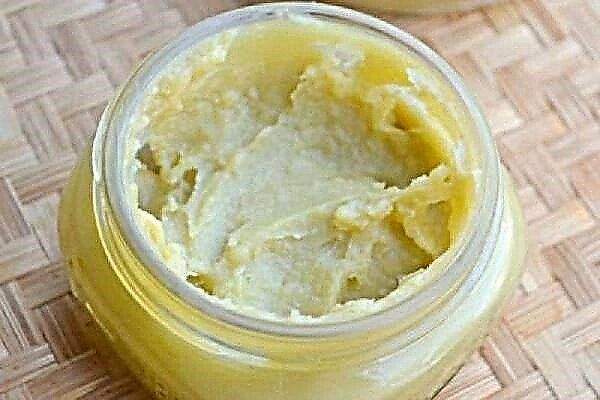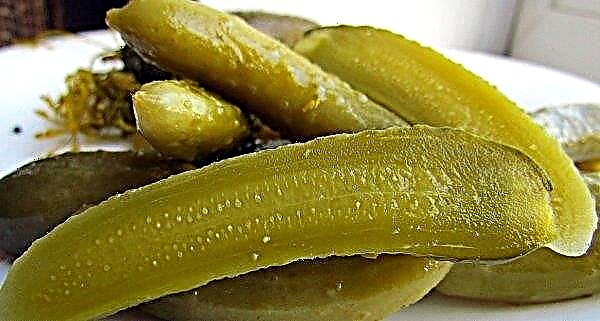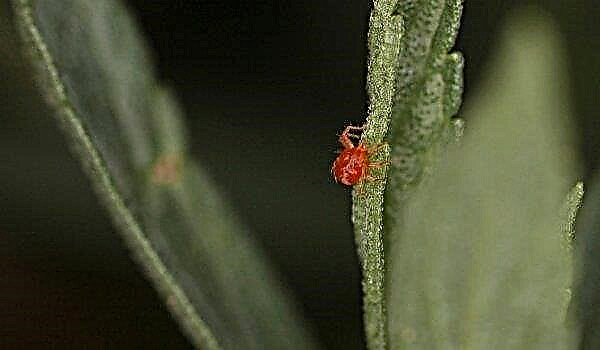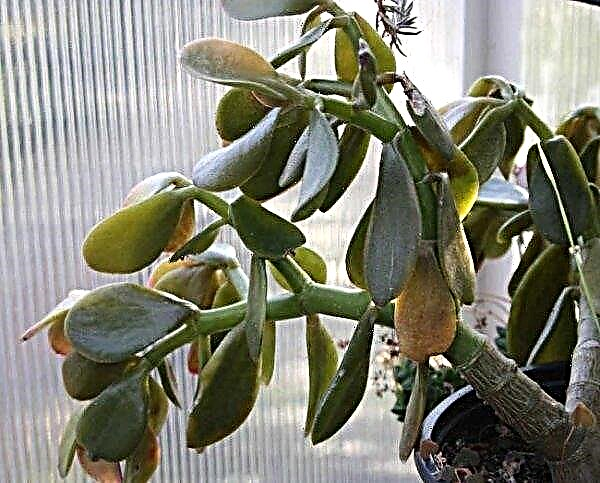Failure to comply with crop rotation, improper planting, disturbances in agricultural technology, and lack of fertilizing are the list of the main reasons why melons become susceptible to pathogens and insect attacks. How to “diagnose” watermelons and how to cure ailments, read in this article.
Common Watermelon Diseases
Each disease has characteristic symptoms by which it can be recognized and proceed to treatment. Most of them are treated with folk remedies and chemicals. However, it is important not to allow pathogens of sores in your garden, observing preventive measures.
Did you know? The remains of watermelons were found in the tombs of ancient Egyptian pharaohs. They were buried with bodies as a source of food in the afterlife.
Fusarium
Fusariosis is a fungal disease that watermelons often get sick with. It manifests itself at any stage in the development of culture. The causative agent is in the soil or in the seeds. The main symptoms are:
- wilt of the stem;
- the appearance of rot on the root neck.
 Fusarium infection affects seedlings of watermelon, adult plants and fruits during storage. herbs. Stopping the development of the disease is capable of introducing nitrate nitrogen into the soil, watering with Previkur (2–4 l / m²).
Fusarium infection affects seedlings of watermelon, adult plants and fruits during storage. herbs. Stopping the development of the disease is capable of introducing nitrate nitrogen into the soil, watering with Previkur (2–4 l / m²).Anthracnose
This fungal disease develops during periods of high humidity and hot temperatures. In addition to watermelons, it also affects melons. Has one more name - a copperhead. The disease can occur at any stage of plant growth. Primary symptoms:
- drilling of leaves;
- the appearance on pumpkins of rounded indentation spots of black color.
 It is not recommended to eat watermelons affected by anthracnose. In the future, the foliage dries out, and the berries are affected by rot. Methods of spreading the pathogen - seeds, plant residues. Fungi get to the plant’s organs with the help of precipitation, wind and penetrate through damage. When the primary signs appear, urgently need to be treated with Oxychom, copper chloride, Ridomil Gold, Previkur, Skor, Fundazol (in accordance with the attached instructions). For prevention, Topsin-M early spring spraying is used in combination with any growth stimulant - Zircon, Epin, and Immunocytophyte.
It is not recommended to eat watermelons affected by anthracnose. In the future, the foliage dries out, and the berries are affected by rot. Methods of spreading the pathogen - seeds, plant residues. Fungi get to the plant’s organs with the help of precipitation, wind and penetrate through damage. When the primary signs appear, urgently need to be treated with Oxychom, copper chloride, Ridomil Gold, Previkur, Skor, Fundazol (in accordance with the attached instructions). For prevention, Topsin-M early spring spraying is used in combination with any growth stimulant - Zircon, Epin, and Immunocytophyte.Root rot
Common causes of root rot are soil waterlogging and temperature changes. The main symptoms are:
- root cracking;
- thickening of the root system;
- yellowing and wilting of foliage.
 To prevent infection, a moderate watering regimen should be observed, periodically sprinkled with wood-ash between rows and treated with Fundazolum (0.1%). Before planting, the seeds should be soaked in potassium permanganate.
To prevent infection, a moderate watering regimen should be observed, periodically sprinkled with wood-ash between rows and treated with Fundazolum (0.1%). Before planting, the seeds should be soaked in potassium permanganate.Important! One of the important rules for growing watermelons, which helps prevent the development of root rot, is the placement of the root neck above the level of irrigation.
Bacterial spotting
Bacterial spotting is one of the reasons why leaves turn black. Pathogenic bacteria are carried by insects. After infection, the appearance of bright spots on the leaves. Subsequently, the leaves turn black, fade, and the plant dies. The manifestation of the disease most often occurs in the first half of summer, when the temperature is set above + 30 ° C, and humidity exceeds 70%. The treatment of the disease is not amenable. There is no means for treating bacterial spotting; the plant is subject to destruction; only its prevention is possible. For prevention purposes, it is necessary to treat the seed with the Fitosporin preparation, and the soil with Trichopol. In early summer, plants are sprayed with Gamair. Very rarely, at an early stage, the culture can be preserved if all infected leaves are removed from it, each time treating the instrument with alcohol.
There is no means for treating bacterial spotting; the plant is subject to destruction; only its prevention is possible. For prevention purposes, it is necessary to treat the seed with the Fitosporin preparation, and the soil with Trichopol. In early summer, plants are sprayed with Gamair. Very rarely, at an early stage, the culture can be preserved if all infected leaves are removed from it, each time treating the instrument with alcohol.
Powdery mildew
The disease is excited by three types of fungi. Infection is indicated by a white coating on the leaves, reminiscent of flour in appearance. The spread of the disease contributes to high humidity, lack of lighting. If symptoms of the disease are detected, damaged organs should be removed and burned, the plant treated with a suspension of karatana (25%). Prevention of the disease is possible by dusting sulfur. Powdery mildew - one of the common diseases in the garden
Powdery mildew - one of the common diseases in the garden
White rot
White rot or sclerotinia is excited by fungi, which are active in high humidity and sudden temperature jumps. The spread of the pathogen is facilitated by thickened beds. Symptoms of the disease include the formation of a white plaque that resembles a web on leaves, flowers and pumpkins. White rot on watermelons is easy to recognize, but it is difficult to deal with it.If signs are found, the affected organs must be immediately removed and burned, plantings treated with potassium permanganate mixed with chalk and diluted in water, sprinkled with charcoal or lime beds. The treatment is also applied with copper sulfate (0.5%).
White rot on watermelons is easy to recognize, but it is difficult to deal with it.If signs are found, the affected organs must be immediately removed and burned, plantings treated with potassium permanganate mixed with chalk and diluted in water, sprinkled with charcoal or lime beds. The treatment is also applied with copper sulfate (0.5%).
Gray rot
The development of gray rot is promoted by high humidity and cold temperatures. The pathogen fungus is transferred from plant to plant by wind and rainfall. After infection, the pumpkins are covered with fluffy mycelium, become soft and watery. All affected organs must be removed. Gray rot affects all parts of the plant, often it begins to spread from the tops of shoots and young leaves
Gray rot affects all parts of the plant, often it begins to spread from the tops of shoots and young leaves
Treatment should be carried out by spraying with the following mixtures:
- zinc sulfate (1 g) + urea (10 g) + vitriol (2 g) + 10 l of water;
- crushed chalk + solution of copper sulfate (in a ratio of 2 to 1).
Mosaic disease
This is a viral disease that cannot be treated. It is important not to allow it into the garden, since you can lose most of the crop. You can prevent the infection of watermelons by the timely destruction of weeds, pests and heat treatment of seeds before planting. Symptoms of the disease - light spots on irregularly shaped leaves, bloating on pumpkins, growth retardation, fruit decay. Productivity in watermelons affected by a mosaic disease is reduced by 50%. Infection occurs from diseased plants by transferring the pathogen by wind or rain, harmful insects. A favorable environment for the development of the disease is increased humidity and temperature indicators at the level of + 20 ... + 25 ° С.
Productivity in watermelons affected by a mosaic disease is reduced by 50%. Infection occurs from diseased plants by transferring the pathogen by wind or rain, harmful insects. A favorable environment for the development of the disease is increased humidity and temperature indicators at the level of + 20 ... + 25 ° С.
Leaf rust
It is excited by a fungus called rusticulata. A characteristic sign of infection is rusty tubercles on leaves and stems. In the future, the tubercles crack, and spores of fungi spill out of them.
 The disease appears on the melon, if there are the following factors favorable for it:
The disease appears on the melon, if there are the following factors favorable for it:
- thickened planting;
- lack of weeding;
- an abundance of nitrogen fertilizers;
- improper watering with moisture on the leaves;
- ignoring autumn harvesting.
Olive spotting
The fungus that causes the disease can persist in the soil for 3 years. It affects all the organs of melon culture that grow above the ground. Irregular-shaped spots form on the leaves, ulcers on the stems and fruits. The ovaries dry and fall. The plant stops growing. Olive spotting develops very quickly, affecting the entire plant. To prevent infection, it is important to adhere to crop rotation rules and thoroughly clean the area in the autumn. Treatment of the disease is carried out with a suspension of cuprozan (80%), benlat (50%), Bordeaux liquid (1%), "Tsinebom" (80%).
Olive spotting develops very quickly, affecting the entire plant. To prevent infection, it is important to adhere to crop rotation rules and thoroughly clean the area in the autumn. Treatment of the disease is carried out with a suspension of cuprozan (80%), benlat (50%), Bordeaux liquid (1%), "Tsinebom" (80%).
Watermelon Pests
With improper agricultural practices, in addition to diseases, watermelons are also attacked by many harmful insects. It is important to inspect gourds more often in order to begin their destruction in time. Parasites not only do great harm to watermelons themselves, but also contribute to the spread of dangerous diseases.
Did you know? Watermelons are grown on the Japanese island of Hokkaido, the crust of which is painted black. Due to their unusual appearance, these pumpkins are the most expensive in the world. In 2008, one watermelon was auctioned for $ 6300 thousand. The average price for one unusual pumpkin is $ 250.
Gourd aphids
Most often, black aphids affect watermelons. This miniature insect settles on the lower leaf plate and sucks the sap from the plants. First symptoms of infection - twisting of leaves, leaf fall, falling flowers. If in time to notice the appearance of a small number of insects, then they can be washed off with soapy water, sprinkled with wood ash or ash-tobacco mixture. In case of severe infection, Inta-Vir treatment is required (1 tablet per 10 l of water, 1.5 l / 10 m²). It’s impossible not to notice aphids on a watermelon, the plant is surrounded by insects
It’s impossible not to notice aphids on a watermelon, the plant is surrounded by insects
Wireworm
The wireworm is called the larva of the nutcracker. It looks like a worm 1-3 cm long, has a rigid body of yellow color. This insect damages the root system. After its harmful activity, the roots begin to rot. Reproduction of wireworms contributes to the contamination of the site, the lack of quality land care. The wire prefers acidic soil, therefore, when preparing the garden bed, dolomite flour, sifted wood ash, egg shell powder must be introduced into the soil. 25 g / m²). Before planting, you should shed the holes with a solution of potassium permanganate. It is also effective to install special traps that catch nutcracker beetles. Treatment with Topaz, Strobi, Tilt will help save plants during infection.
The wire prefers acidic soil, therefore, when preparing the garden bed, dolomite flour, sifted wood ash, egg shell powder must be introduced into the soil. 25 g / m²). Before planting, you should shed the holes with a solution of potassium permanganate. It is also effective to install special traps that catch nutcracker beetles. Treatment with Topaz, Strobi, Tilt will help save plants during infection.
Important! Chemical treatments should be carried out in accordance with personal safety measures, protecting the airways with a respirator, eyes with special glasses, hands with gloves, and the body with protective clothing.
Spider mite
In a hot and dry period, watermelon beds are attacked by spider mites. These small sucking insects feed on plant juices and live on the lower leaf plate. Their presence may be indicated by the presence of a web on ground organs. Small holes form on the top plate of the sheets. As a result, the leaves dry out, the plant lags in growth, and if not treated, it dies. First of all, the spider mite begins to suck out the juice from the young parts of the plant.If there are not many pests, then first you can remove the affected leaves and burn them. In the event of a massive lesion, it is necessary to carry out treatment with the preparations "Fundazol", "Fitoverm", "Bitoxibacillin", "Actofit", "Fufanon", colloidal sulfur.
First of all, the spider mite begins to suck out the juice from the young parts of the plant.If there are not many pests, then first you can remove the affected leaves and burn them. In the event of a massive lesion, it is necessary to carry out treatment with the preparations "Fundazol", "Fitoverm", "Bitoxibacillin", "Actofit", "Fufanon", colloidal sulfur.
Thrips
These small insects with a body length of slightly less than 1 cm with brown wings can be found on leaves of gourds. First, they feed on weeds, and then move on to cultivated plants. Their presence is indicated by small punctures on the leaves. Sucking the juice, thrips eventually lead to the destruction of plants. Heat and dry air contribute to their spread.If you can detect insects when there are not too many of them, then you can resort to treatments with onion husk infusion (pour 1 liter of husk in 2 liters of warm water, leave for 48 hours, add 6 liters of soap and water). For a massive lesion, chemical treatments by Fufanon, Fitoverm, Iskra M, and Commander Maxi are necessary.
Heat and dry air contribute to their spread.If you can detect insects when there are not too many of them, then you can resort to treatments with onion husk infusion (pour 1 liter of husk in 2 liters of warm water, leave for 48 hours, add 6 liters of soap and water). For a massive lesion, chemical treatments by Fufanon, Fitoverm, Iskra M, and Commander Maxi are necessary.
Sprout fly
Insect larvae are especially dangerous for newly planted seedlings and seeds. They can cause great damage to the root system and sprouts. The insect itself looks like a regular fly with gray wings and brown stripes on its back. Body length - 3-5 mm. To get rid of the flies, they carry out triple treatment with insecticides. “Zenkor”, “Hurricane forte” and others are suitable. For the purpose of prevention, seeds are soaked in the “Fentyuram” product (3 g / 1 kg of seeds). The main harm to plants is caused by larvae of the germ fly, but this does not mean that adults do not need to be fought
The main harm to plants is caused by larvae of the germ fly, but this does not mean that adults do not need to be fought
Gall nematode
Nematodes are roundworms with a body size of up to 1 mm. They live underground and affect the root system, leading to the appearance of yellow and brown growths on the roots of the growths. As a result, the plant begins to develop incorrectly, the quality and quantity of the crop is significantly reduced. In case of damage, the gourd looks depressed with twisted leaves. Infection is carried out through the soil, plant debris, inventory. To save the plants affected by the nematode is possible only in case of timely detection of the pest. If the damage is severe, but there are many insects, then there is no point in treating watermelons. At the initial stages, Mercaptophos, Phosphamide, and BI-58 are processed.
Infection is carried out through the soil, plant debris, inventory. To save the plants affected by the nematode is possible only in case of timely detection of the pest. If the damage is severe, but there are many insects, then there is no point in treating watermelons. At the initial stages, Mercaptophos, Phosphamide, and BI-58 are processed.
Butterfly Scoops
Scoops are night butterflies with gray wings. In themselves, they do not pose a danger to plants. Damage is caused by their larvae, which feed on foliage and shoots. First, they eat weeds, and then move to cultivated plants, so when growing watermelons, an important and mandatory procedure is timely and regular weeding. If the caterpillars are affected, watermelons must be treated with wormwood infusion (300 g of flowering grass + 1 tbsp of wood ash + 1 tbsp. Of liquid soap + 10 l of boiling water, leave for 5-6 hours). In severe cases, they resort to the use of Decis, Sherpa chemicals.
If the caterpillars are affected, watermelons must be treated with wormwood infusion (300 g of flowering grass + 1 tbsp of wood ash + 1 tbsp. Of liquid soap + 10 l of boiling water, leave for 5-6 hours). In severe cases, they resort to the use of Decis, Sherpa chemicals.
So, subject to the recommendations for planting and care, watermelons will normally develop and bear fruit. If mistakes are made, then they will begin to hurt and be affected by parasites. In the treatment most often have to resort to "chemistry", which is extremely undesirable for the crop and the human body.


